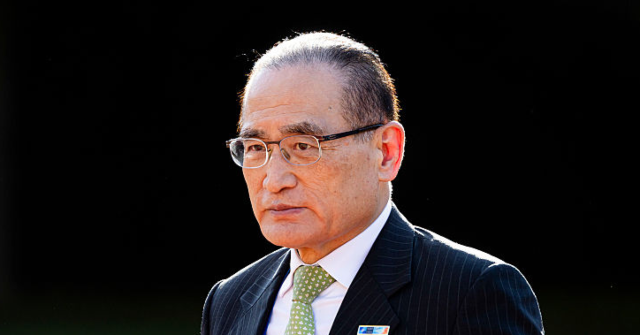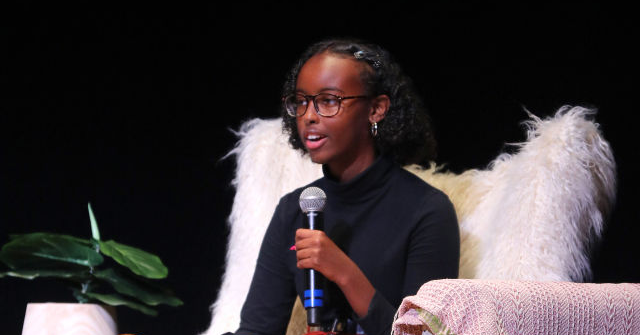 Marinella Senatore, We Rise by Lifting Others, 2023; presented by Mazzoleni. Photo Mazen Jannoun. Courtesy of Mazzoleni and the artist
Marinella Senatore, We Rise by Lifting Others, 2023; presented by Mazzoleni. Photo Mazen Jannoun. Courtesy of Mazzoleni and the artistEach year, Art Basel’s Unlimited sector illustrates unmistakably that the fair is not solely driven by the market but also deeply engaged with institutions and curatorial vision. Its monumental installations, sprawling paintings, towering sculptures, large-scale video and photo presentations and live performances not only speak to current artistic trends but also capture broader cultural and societal undercurrents. This was particularly evident in the fair’s 2025 edition of Unlimited, curated by Giovanni Di Carmine, where the most memorable presentations fell into two broad categories: works that exposed the oftentimes nonsensical existential paradoxes of our time and works that served as avenues of resistance by anchoring in ancient wisdom and ancestral spiritualities that compel us to reconsider our position in the universe. Thus oscillating between rupture and ritual or absurdity and transcendence, Unlimited reckoned with history, ecological collapse and the possibility of collective renewal.
 Atelier Van Lieshout’s The Voyage – A March to Utopia, presented by OMR. Courtesy of Art Basel
Atelier Van Lieshout’s The Voyage – A March to Utopia, presented by OMR. Courtesy of Art BaselTake, for instance, Atelier Van Lieshout’s complex orchestration of sculptures and machines—one of the most ambitious installations and the largest to date in the section, it was in production for four years before debuting in Basel. The Voyage – A March to Utopia unfolds as a parade of inert bodies, an absurdist production line for death and desire that stretched from the entrance of the 16,000-square-meter hall to its distant exit. It stages an epic yet dystopian journey into human fate, suggesting that at this point in civilization, our fate may already be sealed. Disconnected systems and incongruous machines lurch forward in blind pursuit, animated by the collapsing dream of progress and wellness. Comprising more than eighty interconnected objects, sculptures and devices, Van Lieshout’s caravan lays bare our compulsive drive to rule and control bodies, individuals and history itself. It gathers everything and everyone, all the paradoxes of our evolution, into an inclusive march toward nowhere. To pioneer in this world is to set out with fragile hope and to believe, despite everything, in the faint possibility of a happy ending for a corrupted species.
The collapse of American global power was more pointedly represented by Dahn Vo’s In God We Trust: the American flag, with all its stars and stripes, falls into wooden pieces, representing the fall and failure of all the ideologies and worldviews it once stood for.
 Dahn Vo‘s In God We Trust, presented by White Cube. Courtesy of Art Basel and White
Dahn Vo‘s In God We Trust, presented by White Cube. Courtesy of Art Basel and WhiteNearby, Cosima Von Bonin presented a weary Daffy Duck across six black canvases, embodying the darkness and exhaustion of our age using humor and irony as strategies to reflect the absurd conditions of overproduction and burnout. The panels displayed side by side depict a motion and emotion in sequence, such that the viewer animates the works through the act of observing the absurdity of the human condition and the fleeting nature of feeling.
Claudia Comte’s dizzyingly hypnotic installations suggest the relativity and fluidity of our notions of time and space and the complexity of the natural temporalities that contribute to survival, all of which are only truly understandable once we exit the human-centered illusion of linearity. In Basel, the immersive Temporal Drift (coral, leaf, cactus) featured a monumental curved wall with undulating black-and-white patterns inspired by oceanic rhythms, paired with three marble sculptures—a coral, a leaf and a cactus. Together, they suggest the acceptance of relativity and multiperspectivism is the only viable path.
 Claudia Comte’s Temporal Drift (coral, leaf, cactus), presented by OMR, Gladstone gallery, Vistamare and Albarrán Bourdais. Gladstone Gallery, OMR, in collaboration with Albarrán Bourdais, Vistamare Courtesy of Art Basel
Claudia Comte’s Temporal Drift (coral, leaf, cactus), presented by OMR, Gladstone gallery, Vistamare and Albarrán Bourdais. Gladstone Gallery, OMR, in collaboration with Albarrán Bourdais, Vistamare Courtesy of Art BaselIn contrast, many other works in the Unlimited sector attempted to ground the instability of contemporary existence in the timeless symbolism of ancestral memory, rediscovered spirituality and shared mythology. The mythological and magical are reawakened through imagination and ritual of artistic practice, confronting the fundamental human impulse to explain the unknown, impose order on the chaos of existence and give shape to the forces that govern life and death. Most function like myths themselves—embedding, carrying forward and translating systems of meaning as collective efforts to render the mysteries of reality into symbolic form.
An example is Faith Wilding’s Natural Parables (1982), a twelve-part work that weaves a personal, idiosyncratic parable through large watercolor-drawing hybrids paired with seed pod–shaped oil paintings on masonite. Her detailed, nature-inspired imagery intertwines with diaristic handwritten text and symbolic iconography, forming sudden visual and verbal epiphanies that connect ancestral knowledge with embodied awareness. Rooted in her deep research into female mythologies, paganism, Romantic poetry and alchemical manuscripts, the work reflects on women’s transformation, ecological destruction and the body as a politicized natural site, while underscoring the need to reestablish shared mythologies for a fractured world.
 Faith Wilding’s Natural Parables, presented by Anat Ebgi. Courtesy of Art Basel
Faith Wilding’s Natural Parables, presented by Anat Ebgi. Courtesy of Art BaselIn a similar register, Claudia Garay Martinez’s 12-meter-wide mural draws from the deep reservoir of ancestral archetypes shared across cultures, inviting viewers into a symbolically and historically layered cosmos. Elements from her native Peruvian and Andean traditions intersect with references to the Bible, the wheel and the watch—longstanding emblems of what has been defined as “civilization”—while introducing subtle cues that reflect the tensions of our contemporary condition. Indigenous worldviews and embodied knowledge, embedded in these forms, converge and collide with other ancient and modern myths, probing a universal human impulse toward mythopoiesis, or the urge to construct meaning through narrative and symbol. Titled Conversion, the piece unfolds as an open-ended exercise in visual syncretism, embracing the coexistence of multiple, equally valid worldviews born from human imagination across time and culture.
 Claudia Martínez Garay’s Conversiones, presented by GRIMM. Courtesy of Art Basel
Claudia Martínez Garay’s Conversiones, presented by GRIMM. Courtesy of Art BaselTapping into the entire archive of human knowledge, Greek artist Antonis Donef presents a monumental diptych that unfolds across a sprawling array of collaged archival materials, including books, maps, encyclopedias and his son’s sketches. The work reveals strata of memory, emotion and collective knowledge, forming a visual palimpsest that invites personal interpretation and uncovers a dense universe of hidden stories and meanings.
At the same time, in scaling up, artists appear to seek a sense of timeless monumentality and a return to the monument as a form. A striking example is Testimoni, a procession of twenty life-size sculptures carved from volcanic tuff by Italian artist Mimmo Paladino to form an army of totemic, archaic figures. Fluidly blending cultures, styles and symbologies, these archetypes echo Paladino’s earliest figurative works from the 1980s, including a stone series exhibited at the 1988 Venice Biennale. The material itself is telling: volcanic tuff is deceptively fragile, porous yet resilient, tied to ancient Mediterranean civilizations. Each enigmatic figure seems to emerge from the rock’s weathered surface, bearing the scars of time and erosion while quietly resisting the turbulence of world events—silent, enduring witnesses to human history.
 Mimmo Paladino’s Testimoni, presented by Cardi Gallery. Courtesy of Art Basel
Mimmo Paladino’s Testimoni, presented by Cardi Gallery. Courtesy of Art BaselThe hope of refuge offered by ancient materials and cultures resonates in Mario Merz’s iconic igloo: composed of sixteen segments, its structure includes irregular panes of broken glass and a red car door clamped into place with red-handled fasteners. This precarious yet resilient dome—part igloo, part cupola—reads as if a gust of prehistoric wind had scattered the remnants of a shattered, alienated industrial civilization into place.
Nearby, Lee Ufan’s Relatum (2005-2023) evoked a more pure, solid and stoically monolithic sense of monumentality. A single giant stone stands like a prehistoric relic, solemn in the geological history it contains, serving as both an energetic site and a field of illumination—a space for meditative reconnection with a sacred dimension tied to the enduring cycles and forces of the natural world.
 Lee Ufan’s Relatum, presented by Lisson Gallery. Courtesy of Art Basel
Lee Ufan’s Relatum, presented by Lisson Gallery. Courtesy of Art BaselRituals of reconnection and reconciliation with ancient traditions were also explored in a poignant 28-minute performance piece Sham3dan (Candelabra), inspired by a 19th-century style of belly dance traditionally performed during wedding processions. Engaging in an effort of balance and precariousness, the dancers focus on their body movements and relationship with their surroundings to keep the ornamented brass candelabras, complete with lit candles, upright on their heads. An exercise of control and agency, a ritual of ancestral reconnection with the spirits of past performers, the piece creates new modes of commemoration while bearing the weight of that rich past as the dancers advance in a precarious present.
Another kind of rituality was suggested by Hauser & Wirth’s presentation of Felix Gonzalez-Torres’ 1991 Untitled (Go-Go Dancing Platform), in which a lamé-clad go-go dancer suddenly jumps onto a light blue platform, dancing elegantly to the inaudible notes of music playing from a personal listening device. The price? A cheeky $16 million. A sensorial barrier separates us from his engagement with the sound, but his body continues to resonate and amplify those frequencies through its seductive movements until he disappears once more. Conceived a month after the loss of his partner, this performance is a moving celebration of the transient and ephemeral nature of beauty, inviting heightened sensorial attention and appreciation.
 Felix Gonzalez-Torres’ Untitled (Go-Go Dancing Platform), presented by Hauser & Wirth. Courtesy of Art Basel
Felix Gonzalez-Torres’ Untitled (Go-Go Dancing Platform), presented by Hauser & Wirth. Courtesy of Art BaselAmid the endless flux of historical and geopolitical events, Michelangelo Pistoletto envisions the only possible monument for our global civilization as one that is universal and multicultural. In his installation Rispetto (2025), his signature reflective surfaces of mirrors are inscribed with the word “Respect” in multiple alphabets and languages, accompanied by chairs from diverse countries and cultural traditions placed around a mirrored shape of the Mediterranean. This powerful installation becomes a monument to multiculturalism and a platform for cross-border dialogue that celebrates the richness born from continuous cultural exchange through trade, migration and the ceaseless movement of people, languages, materials and resources.
Similarly, Jaume Plensa’s Forgotten Dreams created a resonant monument to universal rights and cross-cultural solidarity: twenty-one cast-aluminum doors inscribed with the Universal Declaration of Human Rights transform this foundational text into an immersive passageway. With one door deliberately left absent, the work invites reflection on the ongoing, collective effort required to realize human dignity worldwide, as those rights too often remain inaccessible for some. By evoking both the presence of individual lives and the unifying power of language, Forgotten Dreams affirms a shared commitment to justice across cultures.
 Michelangelo Pistoletto’s Rispetto. Courtesy of Art Basel
Michelangelo Pistoletto’s Rispetto. Courtesy of Art BaselEmbracing a more fluid, cyclical notion of the historical course and the extraordinariness of fleeting, transient moments, Latifa Echakhch’s Untitled (Tears Fall) offered a powerful poetic metaphor for eternal flux. Her monumental installation—a curtain of nylon threads tipped with glass beads—cascades from the ceiling like a shimmering, porous veil, simultaneously separating and connecting different layers of perceivable reality. The threads refract light, each ending in a vivid burst of blue beads that evoke the fluidity of a waterfall, capturing a hypnotic interplay of ascent and descent. Water, a recurring symbol of human emotion, becomes a metaphor for dualities. As the caption reads: “The ascent of hope and ambition, and the weight of sorrowful rain—still able to feel beauty when things are falling apart.”
SEE ALSO: Jeffrey Gibson On Making Space for Joy and Justice
This idea of openly and playfully embracing “chance” in the flux of events and circumstances that shape our lives is taken further in Piero Golia’s installation Still Life (Rotating Device): a roulette that spins endlessly, rendering everything an accident within the unpredictability of existence. Embracing causality while holding onto faith and agency becomes the only way to enfranchise or liberate oneself from the mundane preoccupations that obscure reality’s inherently absurd yet richly layered nature.
“We contain multitudes,” reads the luminous installation by Italian artist Marinella Senatore that stood at the Unlimited entrance. We carry multiple stories, inspirations and traditions that sustain our ability to imagine alternative futures for a fractured yet profoundly multicultural civilization. “We Rise to Lift Each Other,” proclaims the opening line of the twenty-eight-part light installation that calls for a shared, collective effort to heal and renew the very soul of our humanity. The work draws on quotes attributed to American lawyer and orator Robert G. Ingersoll and to Walt Whitman’s Song of Myself—selections originally chosen by female inmates in Florence and residents of marginalized neighborhoods in Naples. “By reusing these quotes, originally chosen by communities so distant from the context of Basel, I am connecting these two starkly contrasting realities,” the artist explains.
For visitors under Senatore’s installation, Unlimited became a site to stage a collective ritual of civic imagination and reconnection—a space for public engagement that explored the transformative power of community, while reminding us that the richness of our multicultural past and present can be reactivated through works that channel energy, memory and solidarity.
 Didier William’s Gesture to Home, presented by Galerie Peter Kilchmann. Courtesy of Art Basel
Didier William’s Gesture to Home, presented by Galerie Peter Kilchmann. Courtesy of Art Basel











 English (US) ·
English (US) ·  French (CA) ·
French (CA) ·  French (FR) ·
French (FR) ·